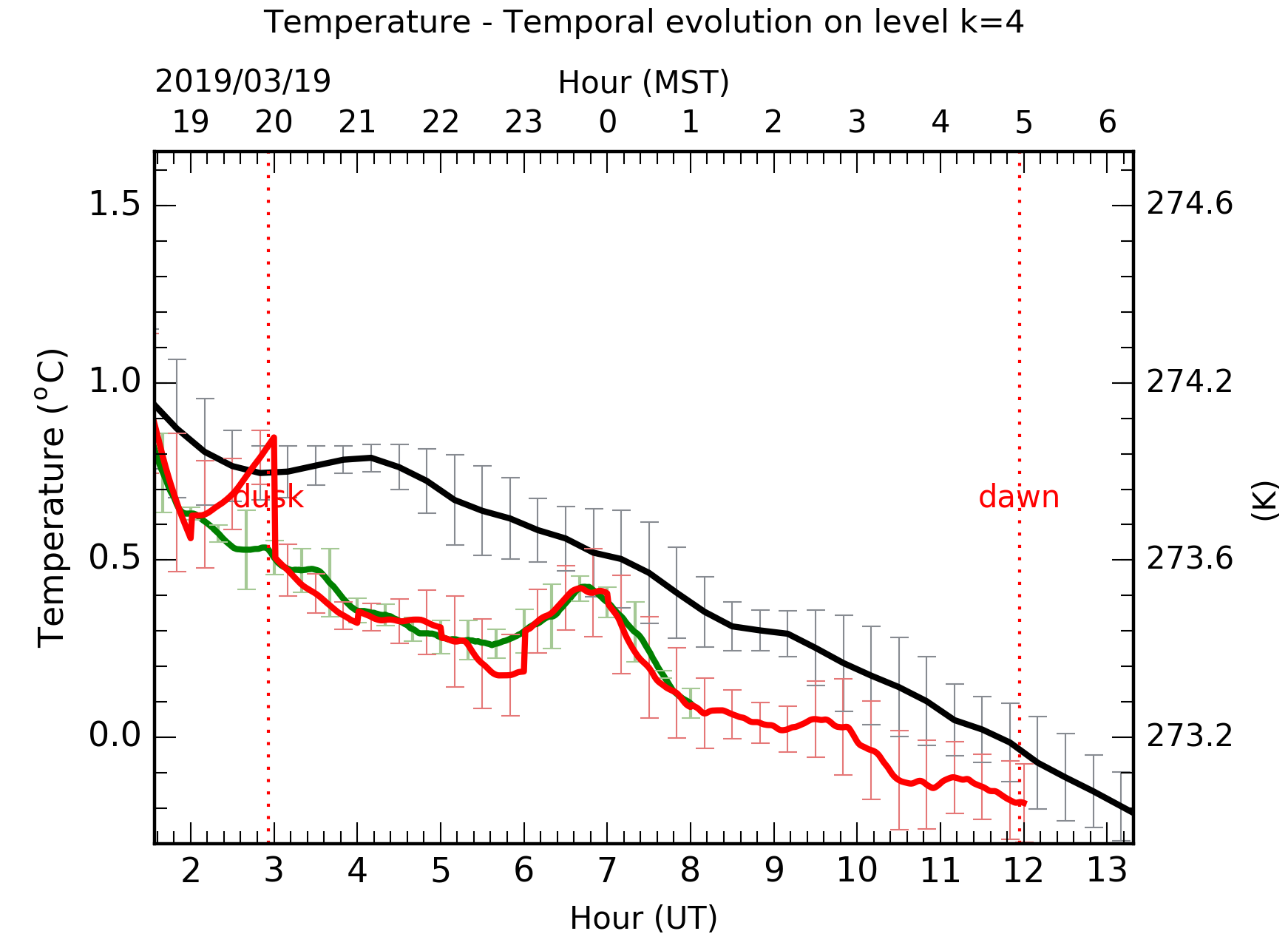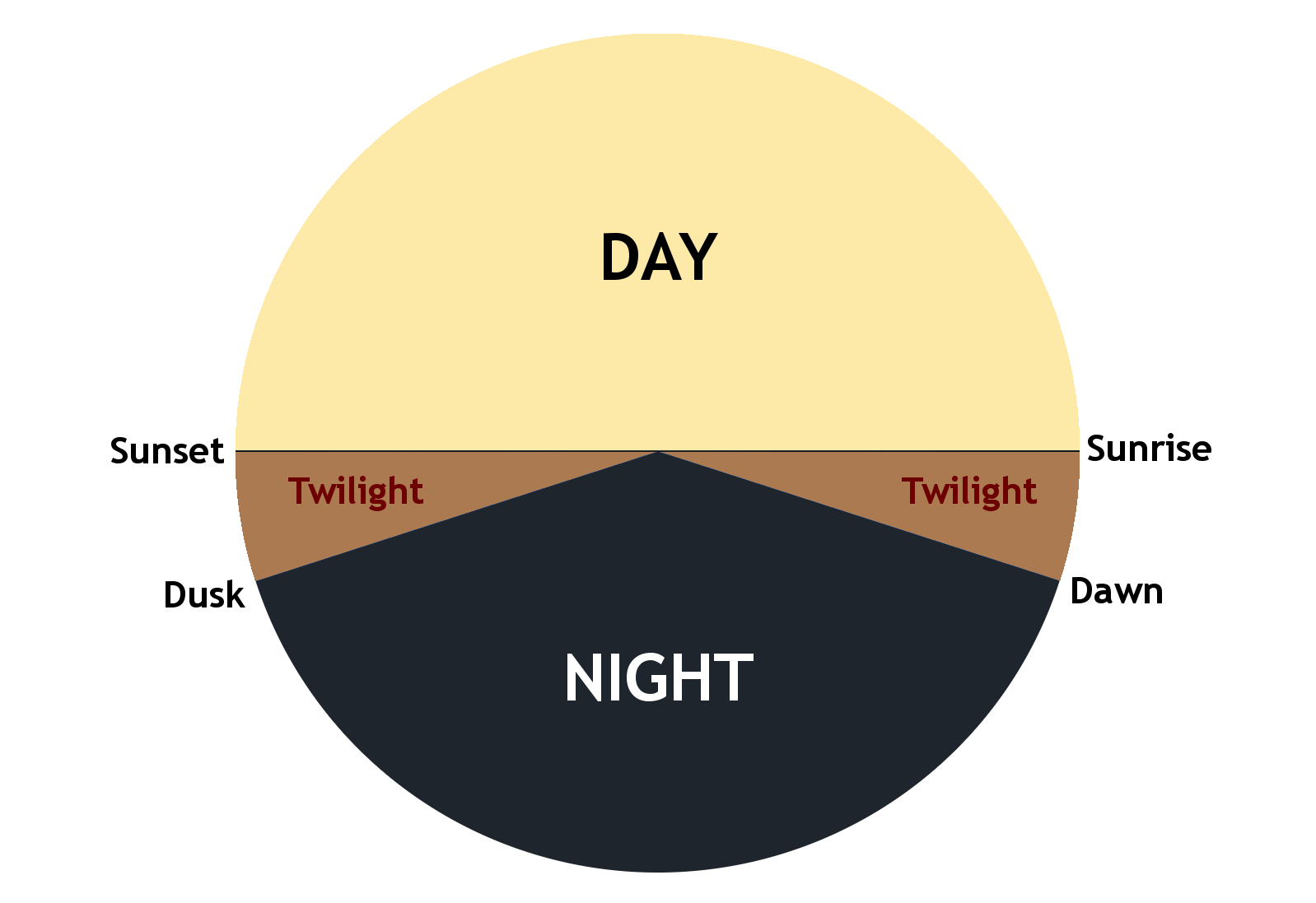FORECASTS LEGEND
-
FORECASTS NEXT NIGHT / FORECASTS PREVIOUS NIGHTS
FORECASTS TIMELINE
FORECAST ON SHORT TIME SCALE
NIGHT PARTITION
FORECASTS CONVENTION FOR NIGHT/DAY PHASES
- FORECASTS NEXT NIGHT / FORECASTS PREVIOUS NIGHTS
When the reader clicks on the link ‘Forecast Next night’ he/she accesses to the forecasts of the next night i.e. the night that is coming. When he/she clicks on the link ‘Forecast Previous nights’ he/she accesses to the forecasts of the three last previous nights. In both options (‘Next nights’ and ‘Previous nights’) the reader can find a summary of the most important key figures of merit condensed in a ‘Forecast in a nutshell’. By clicking on the different curtains visible on the top of the page, he/she accesses to a complete and detailed description of the characteristics of the individual night. The access to ‘Forecast Next night’ is protected by a password. It is accessible only to the LBT community i.e. astronomers in charge to carry out observations, instrument scientists, people in charge to schedule observations and instrumentation to be used during the night.
- FORECASTS TIMELINE
Model forecasts cover the whole night of observations, each night being identified by the date expressed in Mountain Standard Time (MST) when the night is starting (sun set). MST is the local time at Mt.Graham.
In Fig. 1 are shown the UT and MST time axes. Different days are identified following the UT time.
Considering that in principle people could connect to the web site from different locations in the world (Tucson, Italy, Germany, US), in the following lines we report instructions to interpret correctly the model outputs with precise temporal references in order to avoid misunderstandings.
The web site permits the vision of the forecast of the night that is coming (link ‘Forecast Next Night’) let’s call that DAY J (where J is the day in Universal Time (UT)) and the forecasts of the previous nights (link ‘Forecast Previous Nights’).
The simulation of the night DAY J starts at 18:00UT (11:00MST) of the DAY (J-1) (symbol ‘diamond’ on the MST axis).
At 21:00UT (14:00MST) of DAY (J-1) (symbol ‘star’ on the MST axis) the forecast of the DAY J are displayed on the website through the link ‘Forecast Next Night’. At the link ‘Forecast Previous Nights’ are visible the forecasts of the DAY (J-1).
The simulations of DAY J done by the model cover the period starting from 00:00UT of DAY J to 15:00UT of DAY J (or 17:00MST of DAY (J-1) to 8:00MST of DAY DAY J).
The displayed ‘Forecasts Next Night’ covers the time frame between the sunset and the sunrise of the DAY J, which are automatically computed for the LBT site (considering position, altitude and refraction index of the atmosphere). Where possible also the times of the astronomical dawn and dusk are shown. The displayed ‘Forecast Previous Nights’ cover the time frame between the sunset and the sunrise of the DAY (J-3),DAY (J-2),DAY (J-1).
At 16:00UT (09:00MST) of DAY (J-1) (symbol ‘circle’ on the MST axis) the website is updated and the forecasts related to the night that have just ended are moved to the section of forecasts of previous night (see link ‘Forecast Previous Nights’). Just after 16:00UT/9:00MST of DAY (J-1) the website in the link ‘Forecast Next Night’ will show a warning stating that the forecasts of the DAY J will be displayed at 21:00UT/14:00MST of the DAY (J-1).
Initialisation data (i.e. forecast from the ECMWF) are calculated at 12:00UT of the DAY (J-1).

|
|
Fig. 1: Forecast timeline with all the relevant events. Click on the figure to magnify the image. |
- FORECAST AT SHORT TIME SCALE
For those cases in which there are real-time measurements at LBT (for example sensors measuring atmospheric parameters close to the ground or DIMM measuring the seeing) it is provided an additional forecast.
Besides to the forecast of the temporal evolution during the next night that is displayed at 14:00 MST, as indicated in Fig.1 (black line), the website also shows a forecast of the same parameter but updated each full hour and extended for the successive four hours (red line). This procedure is based on a method (Masciadri et. al. 2020, MNRAS) that takes into account both in situ measurements and precedent model forecast.
Fig.2 is an example of the outcomes as are obtained when it is possible to perform the forecasts at short time scales. It shows the temporal evolution of the parameter forecasted at 14:00 LT (black line), the real-time measurements that during the nights are done in situ (green line) and the forecasts obtained by the model and calculated at each full hour(*) starting from the beginning of the night (i.e. at 03:00, 04:00, 05:00 LT) and extended on the successive four hours (red line). The error bars for the short time scale are the same of those calculated for the forecast at long time scale (black line) as indicated in each forecast in the web site.
If the red line is not present, that means that current or previous days real-time measurements are missing. The AR procedure takes into account the real-time measurements related to the last five nights. In order to compute the AR forecast at least one night containing measurements has to be available in the previous five nights. The larger is th enumber of nights N taken into account, the more accurate is the forecast (see Masciadri et al. 2020). When N=5, forecast performances reach a saturation level. The red line is for N=4 or N=5. We change the colour from red to magenta if N=3 or N=2.
(*) Starting from September 2024, the forecasts update is done with a frequency of ten minutes instead of one hour. That means that forecasts are calculated each ten minutes starting from the beginning of the night and extended on the successive four hours.

|
|
Fig. 2: Example plot composed with regular forecast (black line), sensor measurement (green line) and short time scale forecast (red line), computed at 8:00 MST until 12:00 MST. |
- NIGHT PARTITION
The whole year is defined into two macroscopic seasons:
SUMMER: [April – September]
WINTER: [October - March]
When computing time averages, the whole night time frame is divided into three parts, identifying the first, central and last part of the night. The external thresholds are the dusk and dawn. The internal time thresholds depend on the current season as defined previously (see Fig. 3).
FIRST PART OF THE NIGHT: The thresholds are 06:10UT/23:10MST (summer) or 05:30UT/22:30MST (winter).
CENTRAL PART OF THE NIGHT: The thresholds are 06:10UT/23:10MST and 8:50UT/01:50MST (summer) or 05:30UT/22:30MST to 09:30UT/02:30MST (winter).
LAST PART OF THE NIGHT: The thresholds are 08:50UT/01:50MST (summer) or 09:30UT/02:30MST (winter).

|
|
Fig. 3: Night partition. Click on the figure to magnify the image. |





